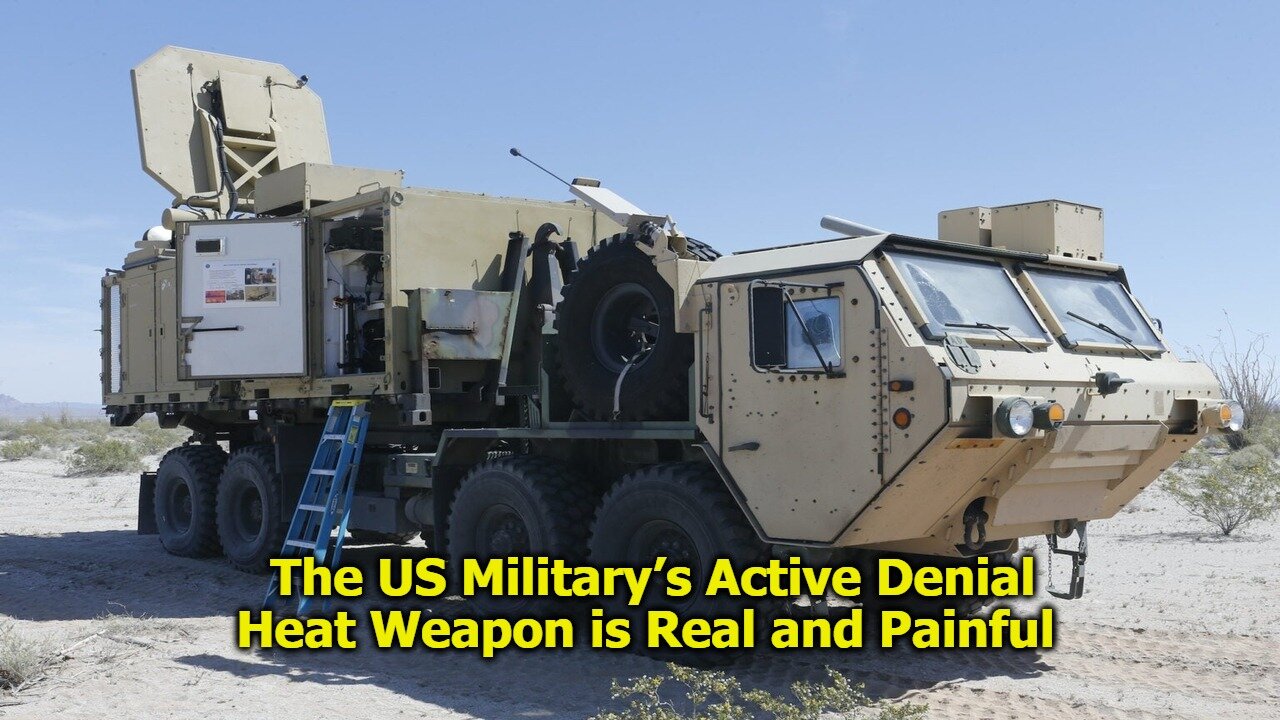Premium Only Content

The US Military’s Active Denial System (ADS) Heat Weapon is Real and Painful
The US military’s heat weapon is real and painful. Here’s what it does.
They claim there is no permanent injury, but evidence from Australia's recent protests challenges that narrative.
Plus, what to know about a sonic tool that’s referred to as “the voice of God.”
The Active Denial System (ADS), is a real thing, as is the sound system, which is called a Long Range Acoustic Device (LRAD).
“This family of capabilities grew out of the DoD’s experience in the 1990s in Bosnia and Somalia. In both instances, you have the military dealing with civilians, who could be violent, but weren’t really combatants.” The intention was to create new kinds of tools that were somewhere between a rifle, and close-range crowd-control gear, like shields and batons.
Because of this experience in Bosnia and Somalia, he says, the Department of Defense “created this non-lethal directorate to explore a whole bunch of technologies.”
The Active Denial System
Then there’s the ADS—the heat weapon. It works, according to the Joint Intermediate Force Capabilities Office’s FAQ page on the weapon, by producing radio waves. It creates a “focused beam of millimeter waves at a frequency of 95 gigahertz”; that beam is “only physically capable of reaching a skin depth of about 1/64 of an inch.” The same page describes the process through which they tested the weapon on volunteers, as well as two burn injuries from it, one in 1999 and the other in 2007.
It doesn’t employ an infrared beam, but instead uses shallow, pain-producing millimeter waves. “What you are feeling is not your skin cooking, but you’re feeling a sensation of pain,” he says. “If you get out of the line of fire, you don’t have a red spot.” Those who have experienced it comment that “it feels like your skin is on fire,” he says.
Ultimately, a weapon like the ADS sits outside of the realm of norms that surround more conventional weapons, says Philipp Bleek, an associate professor at the Middlebury Institute of International Studies at Monterey. “There’s something about exposing people to the feeling of being burned—intensely burned—that I think is instinctively horrifying to people,” he says.
No shit? I think they need to examine it more in-depth after severe burns were reported by peaceful protestors in Australia recently.
Recently, LRADs and ADS have been used against Black Lives Matter protesters in Rochester and also in Australia. I wouldn't put it past Castreau either. Forewarned is forearmed.
Download this .pdf (Portable Digital File) and attach it to an email and send it to all of your friends in Canada and around the world wherever this may be used.
Why They Are So Dangerous
LRADs are designed to produce VERY loud sound, and loud sound can cause
significant damage to our auditory (hearing) and vestibular (balance) systems.
https://www2.naz.edu/files/9416/0020/0385/LRADs__What_They_Are_and_How_To_Protect_Yourself.pdf
More information:
https://www.popsci.com/story/technology/heat-weapon-active-denial-system-ads-lrad-explained/
Human Rights Concerns on Using ADS
Unethical regimes or personnel could easily deny abuses of ADS, as the device leaves no
physical evidence of its use. In addition, because ADS is a new and radiation-based
technology, there is fear that exposure could lead to long-term health effects. While few
human rights organizations have explicitly commented on ADS, many have expressed
deep concerns regarding the use of non-lethal weapons: An analysis of these concerns
can help shed light on likely future objections to ADS deployment and use.
For more information, download this informative .pdf (Portable Digital File) explaining it's use in great detail:
https://www.wm.edu/offices/global-research/research-labs/pips/_documents/pips/2011-2012/active_denial_system.pdf
What about that tinfoil? It will have to cover every square inch and any rips or tears will make it useless. Joints may be tricky; if you flex foil too many times holes start appearing. For vision you will need a metal mesh visor, like the kind they use on microwave oven doors. The problem is, the size of the mesh depends on the wavelength of the radiation - so short-wavelength ADS beam requires something much finer than normal microwave mesh.
Here is the ONLY way to protect yourself on a moments notice from an LRAD. Carry ear plugs, but most people don't insert them correctly to begin with, so in a moment of panic chances are they won't insert them correctly either, and this sonic weapon can cause hearing injuries that will last forever.
It is best to get out of the line of the sound. Both LRAD and ADS work in a straight line, so get out of the broadcast area and quick! See the image below:
LRADS and ADS - How to Protect Yourself
https://imgflip.com/i/663n4i
More information: https://www.military.com/defensetech/2006/12/29/pain-beam-not-easily-foiled
-
 1:05:22
1:05:22
Donald Trump Jr.
7 hours agoAmerica First Means Reviving the American Dream, Interview with Peter Schweizer | TRIGGERED Ep.203
91.6K194 -
 LIVE
LIVE
The Jimmy Dore Show
4 hours agoTrump BETRAYS MAGA For Elon over H-1B Visas! BBC Editor Whitewashes Israel Coverage! w/Keith McHenry
14,750 watching -
 1:34:02
1:34:02
The Officer Tatum
6 hours agoLIVE: Trump ENDORSES Mike Johnson as Elon BACKTRACKS On H-1B + MORE | Officer Tatum Show EP 32
67.2K93 -
 45:56
45:56
Kimberly Guilfoyle
6 hours agoNew Year. Same MAGA Mission, Live with Roger Stone | Ep. 183
75.3K35 -
 1:49:14
1:49:14
2 MIKES LIVE
10 hours ago2 MIKES LIVE #160 We're Back! Deep Dive Monday!
12.1K1 -
 54:28
54:28
LFA TV
1 day agoTrump’s Triumphant Year | Trumpet Daily 12.30.24 7PM EST
22.4K8 -
 DVR
DVR
Quite Frankly
9 hours ago"2024 Review, Homunculus Flu, Old/New Year Predictions" 12/30/24
48.7K6 -
 LIVE
LIVE
RonjnJeremy
11 hours ago $7.89 earnedClassic Wow 20th Anniversary edition HC SF, Rogue..PT8 lvl 46+ Just need to stay alive...
234 watching -
 1:50:28
1:50:28
Jesús Enrique Rosas
8 hours agoEp. 51: Gates wants CENSORSHIP, Colbert MESSES UP, AOC meltdown, Hanks LEAVING and MOAR!
102K52 -
 1:45:47
1:45:47
The Quartering
10 hours agoHuge Censorship Law To Pass, Trump Endorses Johnson, TikTok is Saved? & Today's News!
129K83